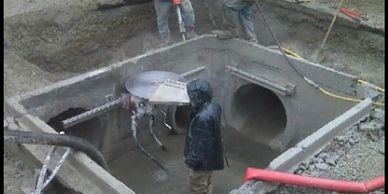Archaeology is a field that constantly seeks to uncover the mysteries of the past. From ancient civilizations to historical landmarks, archaeologists use a variety of tools and techniques to reveal hidden secrets buried beneath the earth. One such powerful tool that has revolutionized the way archaeologists explore sites is Ground Penetrating Radar scanning. GPR scanning allows researchers to see beneath the surface without disturbing the site, providing a non-invasive and efficient method of discovering hidden structures and artifacts.
The Technology Behind GPR Scanning
Ground Penetrating Radar works by emitting high-frequency electromagnetic pulses into the ground. These pulses penetrate the subsurface layers and bounce back when they encounter different materials or objects, creating a detailed cross-sectional image of what lies beneath the surface. Archaeologists can then analyze these images to identify the presence of structures, artifacts, or disturbances without the need for excavation.
Key features of GPR technology include:
- Ability to penetrate various types of materials, such as soil, rock, concrete, and even water.
- High-resolution imaging that provides detailed insights into the subsurface without causing damage to the site.
- Portability and ease of use, making it a versatile tool for fieldwork in remote or hard-to-reach locations.
- Real-time data collection and analysis, allowing researchers to make quick decisions on-site.
Applications of GPR Scanning in Archaeology
The use of Ground Penetrating Radar has transformed the way archaeologists approach site exploration and preservation. By uncovering hidden features and artifacts without excavation, GPR scanning has become an invaluable tool in a wide range of archaeological applications.
Some common uses of GPR scanning in archaeology include:
- Mapping buried structures: GPR scanning can reveal the layout of ancient buildings, walls, and other architectural features without disturbing the site.
- Locating graves and burial sites: GPR can identify unmarked graves, burial chambers, and other funerary structures with high precision.
- Identifying artifacts: GPR scanning can detect underground artifacts such as pottery, tools, and coins, helping archaeologists pinpoint excavation areas.
- Assessing site integrity: GPR technology can assess the condition of archaeological sites, detect potential threats like erosion or looting, and aid in preservation efforts.
Case Studies: Uncovering the Past with GPR Scanning
Several archaeological projects around the world have successfully utilized GPR scanning to reveal hidden secrets and enhance our understanding of the past. These case studies demonstrate the power and effectiveness of GPR technology in uncovering archaeological treasures.
The Stonehenge Hidden Landscapes Project
The Stonehenge Hidden Landscapes Project, conducted between 2010 and 2014, used GPR scanning to explore the area surrounding the iconic Stonehenge monument in England. The project discovered a wealth of new information about the ancient landscape, including previously unknown burial mounds, pathways, and structures, shedding light on the ritual significance of the site.
The Tomb of Nefertiti
In Egypt, a team of archaeologists used GPR scanning to search for the legendary tomb of Queen Nefertiti in the Valley of the Kings. The technology revealed anomalies beneath the surface that could indicate the presence of a hidden chamber, potentially leading to one of the most significant archaeological discoveries in recent history.
Challenges and Future Directions
While GPR scanning has proven to be a valuable tool in archaeology, it is not without its challenges. The technology relies on the skill and expertise of the operators to interpret the data accurately, and environmental factors such as soil composition and moisture levels can affect the quality of the results. As GPR technology continues to evolve, researchers are exploring new ways to overcome these challenges and enhance the capabilities of the technology.
Some of the future directions for GPR technology in archaeology include:
- Integration with other remote sensing techniques to create comprehensive subsurface maps of archaeological sites.
- Development of machine learning algorithms to automate data analysis and interpretation, improving the speed and accuracy of results.
- Miniaturization of GPR equipment to increase portability and accessibility for fieldwork in challenging terrains.
- Collaboration with experts in geophysics and materials science to refine the capabilities of GPR technology for archaeological applications.
